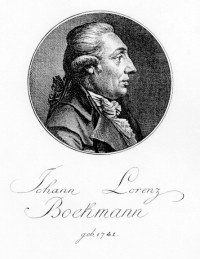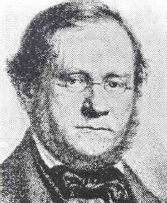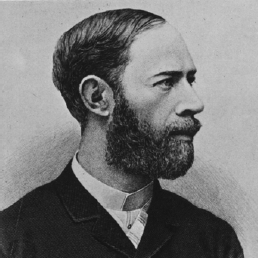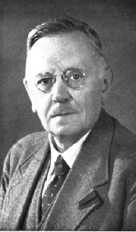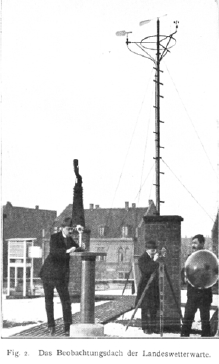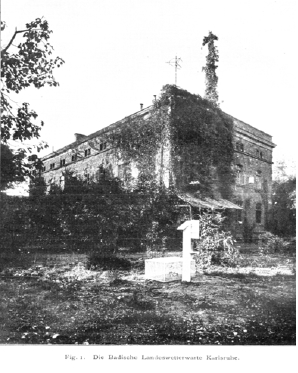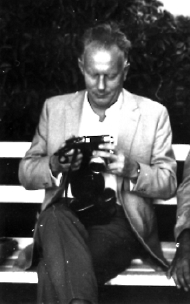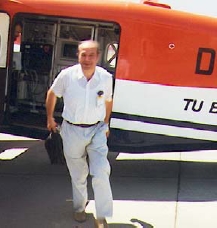History of the Institute
In 1929, the Institute was founded at the Technical University of Karlsruhe under the name of “Meteorological Institute”. Within the framework of an institutionalized cooperation with the Kernforschungszentrum Karlsruhe (Karlsruhe Nuclear Research Center) as it was called at that time, the Meteorological Institute merged in the newly founded Institute of Meteorology and Climate Research – Troposphere Research Division (IMK/TRO) in 1985.
|
The development of the subject areas of today's Research University of Karlsruhe is closely related to historical events and personalities that have guessed far anticipatory the knowledge needs and the importance of new disciplines (Hotz, 1975). This also applies to the atmospheric and climate research, which today is more than ever in the focus of public and political interest by the discussion on climate change and natural disasters. In a brief history of meteorology in Baden some of the most important pioneers of the subject in the region will be introduced . Basis of this review is mainly the collection of historical records in the library collection of the Institute of Meteorology and Climate Research. Prof. F. Fiedler provided other important documents , Dr. Lähne from Mannheim deserves thanks for his research on the history of meteorology in several libraries in southern Germany. The opening speech at the German-Austrian-Swiss meteorological meeting in 2004 in Karlsruhe (Fiedler and Kottmeier, 2004) contained a first summary view of the results. The development of meteorology in the room southwestern Germany, as in other areas of Germany and France, was characterized by three very different periods. Early meteorological observations and records began at the end of the 18th Century and were worn to about 1870 by the initiative of individuals and societies.In the second phase until about 1930 institutions of the countries took over the responsibility. They built on systematic monitoring networks with similar instrumentation and provided for the periodic evaluation and publication of results. By the demands of the emerging aviation and certainly in connection with the growing interest in all scientific and technical methods, in addition to the reunion (especially from 1933) and operation of meteorological services, academic institutions were located and developed further at universities . The beginnings of meteorology from 1778 to 1868 Today´s Institute for Meteorology and Climate Research in Karlsruhe has its origin in a very long tradition of meteorological work. Already in 1778 a monitoring network of meteorological stations was established and the "Badische Witterungsanstalt" was founded at the instigation of the Karlsruhe professor Johann Lorenz Böckmann. This is noteworthy, because it was one of the first meteorological measurement networks at all and existed before the monitoring network of the better known "Societas Meteorologica Palatina". From France the observations of the "Société royale de médecine" are known. At the end of the 1770´s a meteorological monitoring network was initiated there, and a cooperation and exchange with individual observers in other European countries and academies such as the "Societas Meteorologica" was maintaind (Cotte, 1788). The monitoring network of the "Societas Meteorologica Palatina" was founded in 1780 by the scientifically minded Elector Karl Theodor of Bavaria and the Palatinate, led by J. Hemmer in Mannheim, and on the basis of proposals from Boeckmann. This was the first large-scale monitoring network with 39 stations, stretching from North America to the Urals and from Greenland to the Mediterranean. Regular meteorological observations with similar devices of the Societas began on 1 January 1781 and the results were compiled in 12 annual volumes, called ephemeris. After only 12 years, however, the monitoring network collapsed after the death of J. Hemmer, probably because of the French Revolution. Cooperation across national borders subsequently were made almost impossible because of the Revolutionary War until 1815. The first observation series of Karlsruhe includes due to the efforts of Boeckmann, however incomplete, the years 1779 - 1789. This first observation series however didn´t belong to the network of the Societas. In 1798 the son of Boeckmann, Karl Wilhelm Böckmann, resumed the observations and continued it without interruption until 1821. Physics professor Gustav Friedrich Wucherer from the Karlsruhe Polytechnikum that has today become the university continued the observation from 1821 - 1841. Wucherer also had a major role in the founding of the Polytechnikum. With the help of agricultural associations he tried to resurrect a measurement network of voluntary observing stations. As a result at least in Württemberg such an observating network with 15 - 20 meteorological stations existed that were maintained by the Württemberg Agricultural Association.
The Karlsruhe observations were continued until 1868 with great initiative of the physics teachers and professors Stieffel (until 1849), W. Eisenlohr and Heckmann. Thus the relevant physics professor took care of the meteorological measurements
Thus since 1799 until end of 1944 in Karlsruhe itself measurements were performed almost without interruption. Including the break at the end of the 2nd World War II, there is a more than two-hundred year series of measurements, which is one of the longest meteorological series in Germany, particularly regarding the precipitation data. The longest temperature series is from Basel, where the records similarly to Frankfurt were recorded already in 1755, however the Frankfurt series initially only had been continued until 1784.
The period 1868 – 1929 About 1870 in many countries began the establishment of meteorological observation networks under state jurisdiction. In Baden Baden this was the central meteorological station, which was established and chaired by the respective physics professor at the Polytechnic in 1868. After it´s establishment in 1868 the observational network of the Baden meteorological central station consisted of 14 stations second order. As in 1882 difficulties arose at the succession for the Head L. Sohnke, finally the central station was seperated from the Physical Cabinet (and thus from the Polytechnic).
Together with a hydraulic engineering institute it was united to a central bureau of meteorology and hydrography by the Chief Directorate of the ministry for water and street. This change removed the subject from science and research, but this turned out to be extremely important and positive for the further development. Namely, the building officer Max Honsell became director. Honsell later rose to be the finance minister of Baden and still had an important role in the development of the monitoring network and the meteorology in Karlsruhe at all.
Under his leadership, the measurement network was expanded to 16 stations of second and third order, 32 rain monitoring stations with Hellmann devices, 22 snow level-, 70 thunderstorm- and several hail hotlines. The instrumentation of the stations was enlarged significantly, the results were published in annual reports and comprehensive evaluations in "contributions to the hydrography of Baden ". During this time (1887) also one of the first meetings of the German Meteorological Society took place - this was the fourth after its founding on 18 November 1883 in Hamburg and meetings in Magdeburg and Munich. Max Honsell from Karlsruhe was a founding member of the DMG. At the DMG meeting in Karlsruhe one of the greatest scientists of Karlsruhe took part, namely Heinrich Hertz. Hertz had a Chair in Karlsruhe from 1885 - 1889 and discovered here the electromagnetic waves that had far-reaching consequences in the development of communications technology. Heinrich Hertz himself was very interested in meteorological matters and has held his inaugural lecture in Karlsruhe about issues of the energy balance of the atmosphere. A few years ago the manuscript has reached in the possession of the Institute. In his presentation, Hertz has estimated some of the components of the mean global energetics surprisingly close to today's textbook information.
Hertz developed inter alia a thermodynamic chart paper and presented it at the DMG meeting 1883 in Karlsruhe. In an interesting arcticle by H.Hertz in the meteorological journal (1887, 4th year) a reference is made to recovered illustrations of J.L. Böckmann (the so called ,,Meteorographia Universalis auctore Boeckmann’’). Also in the letters of Johann Wolfgang von Goethe there is a repeated reference to this work of Boeckmann.
After Honsells further ascent to the Minister C. Schultheiss and his assistant J. Krauth continued the work of Honsell at the central bureau succesfull but obviously in difficult conditions from 1906 to 1918 . Shurely it is thanks to the perseverance of Schultheiss that during this period the meteorology in Karlsruhe continued to exist and continued to develope. After a short lead of Stoll in 1919 Albert Peppler, born in Hessen, became the new director of the renamed institution national weather center, which was located on the present area of the State Insurance in Karlsruhe. Peppler was interested in synoptic meteorology. With his brother Wilhelm he established a private weather service at the age of 21. Later this weather service became the ,,Hessische landwirtschaftliche Wetterdienst“ at the university of Gießen. He participate in free balloon drive ups and was appointed to an extraordinary professor after succesful work at "Marinewetterdienst" in first world war 1919. Therefore Peppler comes from research and he developed the "Badische Landeswetterwarte". Particulary he deals with aerological questions and he take part in international programms to research the higher atmosphere with registrated balloons. The climate in the region, influenced of radiation, keep him busy as well.
He achieves, that the "Landeswetterwarte" 1921 could obtain new rooms at Durlacher Allee and established the "Badische Gesellschaft für Wetter- und Klimaforschung". His enthusiasm for teaching will prove importantly. His teaching activity meets with response at the technical university and he was appointed honorary professor in 1925. Simultaneously a job as assistent for meteorology was created. Thus the meteorological institute of the technical university develops, established in 1929 with formal degree of ministers for cult and and instruction.
The meteorological institute under the direction of A. Peppler 1929 - 1942 Therefore Albert Peppler was the first director of the meteorological institute. Also he works in the comming years for topics of synoptics and aerology in close contact between "Landeswetterwarte" and university. He looks for ways for medium-term weather forecasting and uses more statistical methods. Alongside he works with climatological questions, for example research with snow depth, visibilty range and atmospheric opacity as well as with UV radiation. The results were detailed published in the information of "Badische Landeswetterwarte".
1934 the "Landeswetterwarte" was dissolved and it remains the small-sized institute, because Albert Peppler forbear from being assumed by the "Reichswetterdienst". The institute has to move to the bulidings at botanical institute". Important equipment is missing with the exception of gadgetry for research and books from polytechnicum. The budget is limited and only the techical public social aid is available. After beginning of war 1939 there was a urgent need for young meteorologists. Peppler defends oneself against to educate meteorologists under conzessions with depth and breadth of expert knowledge. (Linke, 1942; Schmauß, 1942). 1941 Albert Peppler falls ill and dies at 19. Mai 1942. The son of Albert Peppler, Mr. Dr. Wilhelm Peppler and his wife keep in touch with the institute till this day.
The meteorological institute under the direction of Max Diem 1943 - 1978 1042 Max Diem was appointed to director of the meteorological institute by the minister of education at the age of 30 years. First of all, the institute with damages from war was placed in "Westhochschule", where works to cloud and rain physics and airmonitoring were registered. Diem received the doctorate with F. Linke and habilitate with August Schmauss. Diem was good in obtaining funds of the industry and energy public utility and had material expenses available for gradually expansion of the instrumental and personal settings. Since 1950 you could end your studies with meteorology with a diploma, and 1962 Diem succeeded it, to fix meteorology with an own professorship. The accommodation of the institute changed in 1968, it moved to the supreme floor (13. floor) of the new built high-rise building of physics within the large campus. The topics of Diem were applied meteorology, technical and regional climatology, the physics of clouds and rain, pollutant dispersal, boundary layer of the atmosphere and measuring methods. As a central topic, he execute elaborately spectral drained measurements of raindrops with special filter. As a enthusiastic pilot, he received drops in clouds with
oil slicks, which were just evaluated microscopical on the fly. He practice new methods and available were developed. In the last years of his working he deal with ice segregation at laboratory. Diem was just performing pioneer work on this topic, so that this is a topic till this day in Karlsruhe and other locations with essential forward methods. Also the accommodation of an second professorship, which was taken by Karl Höschele in 1973, was a essential earning of Diems. Max Diem was retired in 1978 and dies in 1996.
Das Meteorologische Institut unter Leitung von Franz Fiedler 1978 – 2003 1978 Franz Fiedler was appointed to be a follower for the professorship of Max Diem. Under his leadership, the Institute expanded the scope of its research activities. Based on question of atmospheric turbulence and boundary layer, there were mainly processes on the mesoscale investigated, ie. operations with about 2 km to 2000 km horizontal extent. The institute participated at major research programs in Germany, Switzerland, Austria for the investigation of cross-border transport of air pollutants and the wind systems in the complex orography of the region. Larger measurement programs take also place in spain for desertification, in brazil and chile for regional climate processes and in the south of france for transport of pollutants. The development of numerical, non-hydrostatic model system KAMM (Karlsruher Mesoscale Model) and the full-compressible version KAMM 2 and the model application accompany the implementation of the monitoring programs. The trinational Regio-air-project REKLIP at upper rhine valley and the "Klimaatlas Oberrhein Mitte-Süd“ realized a regional climate study with great information density and high spatial resolution. (Fiedler, 1999).
The work of Prof. Höschele focused mainly on urban climate studies and pollution problems in densely populated areas. As a sought-skilled in this field, he worked for many urban planning measures as an environmental consultant and also in international cooperation, e.g. he was involved with the japanese cities. As successor of Prof. K. Höschele, Prof. Dr. Klaus Dieter Beheng was appointed in 1996. He represented the theoretical meteorology in teaching and research. His research interests are mainly the cloud physics and radar meteorology. Further he developed numerical cloud models, checked them with cloud and precipitation radar data and used the result to improve weather forecasts, especially precipitation. A third professorship was established in 1997, occupied by the author (Prof. Ch. Kottmeier) for the first time. Work with a focus on experimental work were directed on processes of the water cycle and in particular convective systems. For this purpose, measuring instruments are used from the ground and from aircraft and they developed new measurement methods. An important event during the period of management of the Institute by Prof. Fiedler, 1985 was the merger of the Meteorological Institute of the University with matching fields of work at Forschungszentrum Karlsruhe for "Institute for Meteorology and Climate Research". In this way and because of the appointment of Prof. Herbert Fischer at the "Forschungszentrum", an extension of the work focuses on an new institute Atmospheric Trace Gases and Remote Sensing" carried out in 1995, the construction of a third institute area of IMK "Atmospheric Aerosol Research", headed by Prof. U. Schurath followed. The inclusion of the "Institute for Atmospheric Environmental Research", headed by Prof. W. Seiler and headquartered in Garmisch-Partenkirchen in 2002 (previously Fraunhofer-Gesellschaft) in the Forschungszentrum Karlsruhe led to the currently valid structure. Conclusion and structure of today's Institute The joint sponsorship of the Institute of Meteorology and Climate Research, by the Forschungszentrum Karlsruhe and the Universität Karlsruhe was a nucleus of today full merger of the two carriers means for Karlsruhe Institute of Technology. The "Tropospheric Research" is headed by the author Prof. Dr. Ch. Kottmeier and the area "Atmospheric Trace Gases and Remote Sensing", headed by Prof. J. Orphal. Other professors are Prof. S. Jones, who is concerned with the dynamics of the atmosphere and in this case especially with tropical and extra-tropical cyclones, and Prof. K. Beheng with a professorship for theoretical meteorology. The "Atmospheric Aerosol Research" is operated by the Karlsruhe Research Center in cooperation with the University of Heidelberg and is since 2006 under the direction of Prof. T. Leisner. The Atmospheric Environmental Research" in Garmisch-Partenkirchen is headed by Prof H.P. Schmid and has close links to TU Munich and university Augsburg by Prof. H. Kunstmann. The structure and his tasks of the present institute are described in detail at another place (Kottmeier und Fischer, 2004), so that here is no presentation of it. At Karlsruher Institut für Technologie (KIT) the institute for meteorology and climate research can deem as a prototype in small scale. The close connection to the research by a joint research program, access the university researchers to large-scale facilities of the research center and the integration of its experienced scientists in teaching has already proven itself more than two decades.Literature
|
|||||||||||||||||||||||

